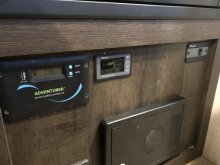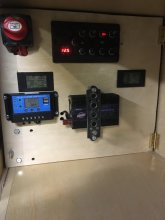I just moved into an older fifth wheel RV that was not built for off grid use. I am working to change that.
My current system is 2 RV/Marine Flooded Lead Acid Batteries, a converter, a basic DC system with some lights, a water pump and a Maxx-Air fan.
Long term, my plan is a battery bank that can power an inverter for AC systems, moving as many systems to DC as possible, and a charging setup that can charge from Solar, Grid AC power, a generator, and an upgraded alternator in my truck. Unfortunately, I can't afford to make all of these upgrades at once, but I have found a decent park to live in full time while I work, upgrade and prep for more of an adventure.
I would like to start with an inverter charger setup, because I am out in California and at the bare minimum, I would like to be able to roll over to my inverter in case we catch a blackout. My purchase plan is inverter/charger -> generator -> batteries -> alternator upgrade/connections -> solar. But I don't want to replace anything as I build on.
But before I can buy anything, I need to know how much power my system is using.
Any suggestions for an energy monitor to properly start sizing my system for my 50 amp 5th Wheel (w/2 air cons, but I don't plan to run them on batteries).
Also, I am planning to use a hybrid inverter so I can live life as normal when connected to a 30 amp or 15 amp 110v outlet (including at least one air con). How should I consider that in my sizing plans?
My current system is 2 RV/Marine Flooded Lead Acid Batteries, a converter, a basic DC system with some lights, a water pump and a Maxx-Air fan.
Long term, my plan is a battery bank that can power an inverter for AC systems, moving as many systems to DC as possible, and a charging setup that can charge from Solar, Grid AC power, a generator, and an upgraded alternator in my truck. Unfortunately, I can't afford to make all of these upgrades at once, but I have found a decent park to live in full time while I work, upgrade and prep for more of an adventure.
I would like to start with an inverter charger setup, because I am out in California and at the bare minimum, I would like to be able to roll over to my inverter in case we catch a blackout. My purchase plan is inverter/charger -> generator -> batteries -> alternator upgrade/connections -> solar. But I don't want to replace anything as I build on.
But before I can buy anything, I need to know how much power my system is using.
Any suggestions for an energy monitor to properly start sizing my system for my 50 amp 5th Wheel (w/2 air cons, but I don't plan to run them on batteries).
Also, I am planning to use a hybrid inverter so I can live life as normal when connected to a 30 amp or 15 amp 110v outlet (including at least one air con). How should I consider that in my sizing plans?




